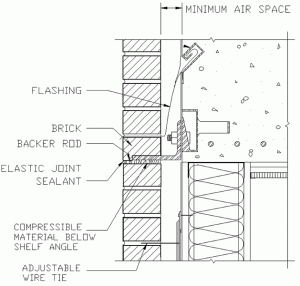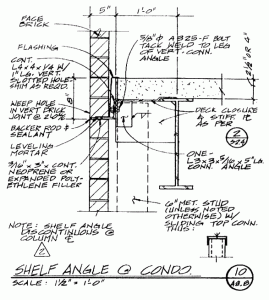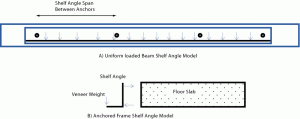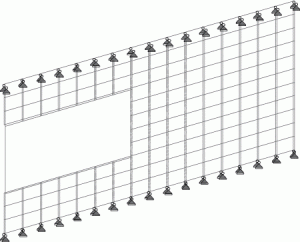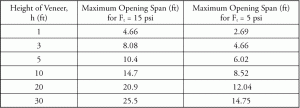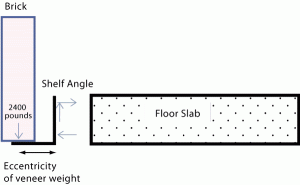Anchored masonry veneer wall systems are commonly used throughout North America in residential, commercial and institutional construction. These exterior masonry veneers are non load-bearing and are usually assumed to be little more than an exterior finish of the building envelope. Using prescriptive design methods, masonry veneer can be supported vertically by foundations for heights less than 30 feet, or supported by the building frame for taller structures. The purpose of this article is to discuss the design of the vertical support of masonry veneers and how this design might be attempted under the current building code provisions.
As shown in Figure 1, these exterior wall systems include an outer wythe (layer) of masonry veneer attached across an airspace to a backing wall by anchors. Typically, these backing wall systems can include sheathed wood, steel stud walls or concrete masonry walls. Masonry veneers can also be attached to poured concrete walls. The veneer wythe is most commonly constructed using units of clay or concrete masonry, bound together by mortar. These veneer masonry units vary from a nominal 2-5/8 to 4 inches in thickness.
For the design of masonry veneer systems, model building codes in the United States reference Chapter 6 of the Masonry Standards Joint Committees’ Building Code Requirements for Masonry Structures, TMS402/ACI530/ASCE 5-08 (MSJC, 2008). The provisions in this standard describe two methods for veneer design, although the prescriptive method is used almost exclusively in North America. In these prescriptive design requirements, veneer backed by steel or wood stud wall systems over 30 feet in height must be supported at each floor level. Even though not required for other backing systems, masonry veneer wall systems are routinely also designed to be supported at each floor level to limit differential movement problems.
As shown in Figure 1, the vertical support of the veneer is typically provided by a steel (shelf) angle that is attached to the building structural system. This connection often uses anchors embedded in the floor slab. The slab edge is then supported by a spandrel beam. In steel structural systems, the shelf angle can also be attached to the spandrel beams directly using shear plates as shown in Figure 2. The beams and supports are designed to resist the applied loads with beam deflections limited to L/600 under service level live and dead loads.
The design of the shelf angle support is typically handled as part of the structural engineering design using a variety of design assumptions. These assumptions vary from assuming that the steel angles span in simple bending between anchor points while supporting a uniformly distributed dead load, to assuming the angle legs act as a bolted frame with a vertical dead load applied to the end of the horizontal leg (Figure 3).
Unfortunately, none of these models accurately describe how the angle and veneer behave. The beam model ignores the significant torsion that is applied to the angle. Since angles have little torsional resistance they will rotate away from the slab, forcing greater loading on the angle sections near the anchors and may result in undersized shelf angle designs. Even though the frame model is more accurate and generally conservative, it also ignores the interaction of the brick and the shelf angle. In addition, the frame model requires assumptions be made relative to the effective width of the angle and tributary length wall. The thickness of the angle is highly dependent on these two assumptions, and designs often result in high angle thicknesses, especially as designers react to the higher insulation requirements of the new energy codes with longer angle lengths.
Although not usual, more sophisticated finite element models of the veneer wall system can be constructed and, if the deformation of the ties and systems and supports are properly modeled, can be used to accurately analyze the behavior of the wall system. Figure 4 shows a typical model of a veneer wall system. The veneer can be modeled using plates elements, the ties modeled as axial elements and the stud backing modeled as beam elements. These models can also be extended to incorporate models of the spandrel beams as well.
Although finite element analyses can provide accurate prediction of behavior of these systems, this level of analysis effort is not typically warranted in most designs. However, the author has conducted a number of finite element analyses on these systems during the course of failure investigations and retrofit studies, and the results of these analyses suggest a pattern of behavior that can be used to design shelf angles using more approximate analysis techniques.
The finite element analyses indicate that the veneer and shelf angle supports interact, and the veneer is much stiffer than the angle, especially away from the anchor locations. Thus, the shelf angle provides much less support away from the anchors as the angle twists away from the slab edge or shear plate connectors. Away from the anchors, the steel angle provides much less support and the veneer is essentially acting as a beam, transferring the veneer dead load to the stiffer angle section near each anchor. Using this behavior as a guide suggests that a reasonable design approach would be to assume that the veneer will act as a beam spanning horizontally in-plane between anchors.
If it is conservatively assumed that the brick veneer spans between anchor supports as a simply-supported, uniformly-loaded beam, then an appropriate anchor spacing and loading can be determined. Just how far a given height of veneer can span can be determined by applying the rational design methods described in the MSJC provisions.
To design the veneer as a beam, the allowable stress design procedures described in the masonry standards can be used. For example, if it is assumed that the dead load of a nominal 4-inch clay brick veneer produces a maximum vertical uniform load of 40 psf for a unit area of the wall face, then a uniform load (w) of 40 x height of brick above the angle must be resisted by the veneer acting as a beam. This load will produce a maximum moment and shear (Mmax and Vmax) of:
Mmax = 40 h (Lspan)2/8 = 5 h (Lspan)2 Equation 1
Vmax = 40 h (Lspan) /2 = 20 h (Lspan) Equation 2
where h and Lspan are in feet and w is in psf.
If it is assumed that the brick supports itself over the anchor spacing in simple elastic bending, then the critical maximum flexural stress (ft) produced by the moment (Mmax) must be limited to an allowable flexural tensile value (Ft).
ft = Mmax / S ≤ Ft Equation 3
where S (section modulus) = bd2/6, for a rectangular section S = t (h)2/6 Equation 4
The Masonry Standards Joint Committee [MSJC, 2008] code lists no limits for in-plane flexural tensile stress parallel to the bed joint. The flexural tensile stress limits (Ft) that it does present in Table 2.2.3.2 are for out-of-plane loading, and these vary from 15 to 80 psi for solid masonry units. Even though the allowable in-plane flexural tensile stresses parallel to the bed joints may be even higher than these values, the following analysis conservatively uses the lowest allowable out-of-plane strength value of 15 psi (solid masonry, Type N masonry cement Mortar). It should also be noted that the allowable flexural stress values in the 2011 version of the MSJC masonry code have been increased from the values described above, and even longer spans can be accommodated if these provisions are used.
For a solid veneer section, the design inequality is given by:
ft = Mmax / S = 2.5 (Lspan)2/(t x h) ≤ 15 Equation 5
where h and Lspan are in feet and t is in inches and ft is in psi
For a nominal 4-inch veneer, this reduces to: 2.5 (Lspan)2/(3.625 x h) ≤ 15
Equation 5 can be used to determine the maximum spans for various uninterrupted heights of veneer for a variety of veneer spans (anchor spacings) as shown in the Table. A similar analysis can be conducted with a 5 psi limit (1/3 of the previous limit) on the flexural stress and these opening heights are also shown in the Table. This lower Ft value is presented to illustrate that even if there is some question about the long term strength of the veneer, it can span a significant distance for even very low strength values. Furthermore, much longer spans can be realized if bed joint reinforcing is included in the veneer as these wires will allow the brick to act as a reinforced masonry beam.
Shear stress is not critical, since calculations show brick sections will be able to support its own weight for spans over 50 feet without exceeding the MSJC code defined allowable shear stress of 37 psi.
Examination of the Table indicates that the brick is likely to support itself in simple bending if there is a sufficient height of brick. Even a 1-foot height of brick can span significant anchor spacings, although the lower heights of brick can easily be assumed to be supported by the angle even though the relative stiffnesses would suggest the brick will carry most of the load. The anchor spacing is thus likely to be determined by the anchor capacity for larger heights of veneer, although care must be exercised to account for any movement joints in the veneer to ensure they are not causing a break in the continuity of the veneer in locations that might over stress the veneer. This is not very likely, since the veneer can also cantilever over a significant distance.
Once the anchor spacing is determined, the steel angle can be designed. In addition to acting as a form for the veneer and providing support to flashings and other wall systems, the angle must transfer the veneer loads to the structural support through the anchors. The tributary length of the veneer can be assumed equal to the span of the veneer used to determine the anchor spacing, and will include the additional weight of the shelf angle. The effective length of the angle resisting the veneer loading is a little more difficult to determine. Connection detailing, height of veneer, length of angle legs and angle thickness will all affect how much of the angle is effectively resisting these reactions. However, assuming that the effective length of the angle is 4 x (the nominal veneer unit thickness) has given reasonable results and appears to be supported by the results of the finite element analysis. This 4 x (the nominal veneer thickness) product was also used to determine the effective length of masonry wall under concentrated loads in older versions of the masonry standard, and thus has been used to describe effective width of steel and masonry systems in the past.
Once the loads and the effective length of the angle are determined, it is a simple matter to determine the thickness of the shelf angle using the simple frame model as described in Figure 3.
As an example, a 10-foot height of 4-inch clay brick veneer and an anchor spacing of 6 feet would produce a loading of
R = 40 psf x 10′ x 6′ = 2400 lb.
Adding an additional 10 lb/ft for the angle weight results in R = 2460 lb. (note that the Table indicates that less than 3 feet of veneer could span this 6 foot anchor spacing, even if simple span supports and an allowable stress of 15 psi was assumed.)
Using the 4t product, an effective length of 16 inches of steel angle can be used to resist this loading (4 x 4 = 16).
If a 6-inch by 6-inch equal legged angle was used to support the veneer, the approximate angle loading shown in Figure 5 can be assumed.
To determine the thickness of angle needed, the veneer weight is often assumed to be applied at the end of the horizontal angle leg. This condition will never happen since the angle will deform, forcing the effective loading point closer to the angle heel. In most cases, it would be reasonable and conservative to assume that the veneer weight is applied in the center of the veneer. If this assumption is used and it is assumed that a 2-inch cavity is present, then a moment on the lower leg would be Mmax = 4.19 in. x 2460 lb. = 10,307 lb. in. The 4.19-inch eccentricity was calculated to the center of the vertical angle leg assuming a ¾-inch thick angle, a 2-inch cavity, and one-half the brick thickness (e = 1.8125 + 2 + 3/8 = 4.19 inches).
Assuming A 36 steel and using AISC LRFD Design procedures:
Zx required = Mmax factored / 0.9 Fy = 1.2 x 10,307/0.9(36,000) = 0.424 in3
Since Zx = bt2/6 = and the effective length of the angle is 16 inches, a minimum thickness of angle should be 0.424 = 16 x t2/6 = 0.399 inches.
A 7/16-inch, A36 steel angle would work to support this load. Note that that eccentricity used in the above calculation has a significant impact on the thickness of the angle and will vary depending on the angle and cavity configuration. This distance should be minimized as much as possible.
The vertical leg of the angle would also have to be evaluated and sized. Equilibrium would suggest that the vertical leg would have to resist the same moment at the junction of the two legs, as well as the tension force produced by the shear force at the connection. For this case, the tension stress on the same effective length of the angle would be less than 500 psi (less than 2% of the capacity) and can safely be ignored. The vertical leg and horizontal leg would be designed for the same moment and thus be the same size. Note that this analysis ignores any shear lag effects.
As can be seen from the analysis presented above, a reasonable angle thickness and support spacing can be determined. Deflections of the angles are not limited, since these deflections will occur as the wall is being constructed. The purpose of the deflection limits in masonry design standards is to preclude excessive cracking of the hardened unreinforced masonry. As these angle deflections occur primarily before the masonry sets up, they can usually be ignored.
The previously described design method requires that the masonry veneer remains intact over the assumed anchor spacing. This is likely to be the case. Even if the brick does crack, however, there will likely be at most two sections of brick acting over a given span. This configuration puts much lower load on the steel shelf angle than a uniform loading and, in the extreme case, will create an arch whose thrust will be balanced by masonry on each side and/or friction on the steel angle.
Summary
The previous discussion presents a design method that can be used to design the vertical supports of masonry veneer wall systems. It should be noted that this design methodology is based on a number of conservative assumptions and is likely to result in conservative designs in most typical design conditions. Designers are encouraged to analyze the veneer wall systems, and their supports using a finite element model in more unusual conditions.▪

